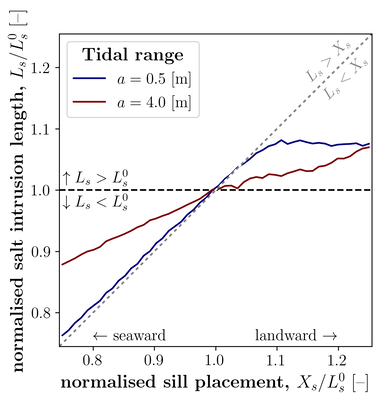G.G. Hendrickx1*, L.A. Manuel2, S.G. Pearson1, S.G.J Aarninkhof1, E.A. Meselhe2
1 Delft University of Technology, the Netherlands; 2 Tulane University, LA, United States of America
* Corresponding author: g.g.hendrickx@tudelft.nl
Introduction
At a global scale, estuaries are vital economic hubs, in part due to the combination of their access to inland regions via river systems with their proximity to sea. However, with the sea in close vicinity also comes the threat of freshwater contamination by saline seawater, especially during droughts. This study explores the potential of a mitigation measure to estuarine salt intrusion, namely the construction of a (temporary) earthen sill – a measure implemented in the Lower Mississippi River near New Orleans (LA, USA).
Objective and Methods
With the use of Delft3D Flexible Mesh, a sensitivity analysis on the design criteria for a sill has been investigated, with a focus on its effectiveness in mitigating estuarine salt intrusion. This analysis uses idealised estuarine morphologies in combination with 3D-simulations, and focuses on the stratified domain, i.e., salt wedge estuaries.
Results
The tidal range has a large impact on the effectiveness of the sill in mitigating salt intrusion (Figure): a large tide, the sill acts as a speed bump for the salt wedge propagating landward; a small tide, the landward-propagating salt wedge experiences the sill as a wall. In a microtidal estuary, the landward salt flux is dominated by the estuarine circulation, which cannot provide the leverage to push the salt wedge over the sill because it has to overcome its own driving force: gravity. In a macrotidal estuary, the tidal oscillation does provide the required momentum to push the salt wedge over the sill. Despite the sill being overspilled, the presence of the sill does reduce the salt intrusion in a macrotidal system, albeit less effectively than in a microtidal system. In both cases, the sill is most effective when it is approximately half the water depth in height.
Conclusion
A sill can be an effective measure to mitigate estuarine salt intrusion. The location and height of the sill largely determine the effectiveness as mitigation measure. Lastly, the sill is most effective in mitigating salt intrusion in microtidal systems, when salt transport is dominated by the estuarine circulation.

Salt intrusion length (Ls) versus sill placement (Xs) normalised by the salt intrusion length without a sill (Ls0). Sill placement is the distance of the sill from the estuary mouth. (Figure from Hendrickx et al., in review.)
References
Hendrickx, G.G., Manuel, L.A., Pearson, S.G., Aarninkhof, S.G.J., and Meselhe, E.A. (in review). An earthen sill as a measure to mitigate salt intrusion in estuaries. Submitted to Estuaries and Coasts [Nov. `23].










